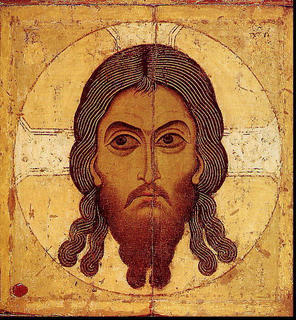Icon of the Savior "not-made-by-hands"

Today, on the Church Calendar, is the Feast of the Translation of the Icon of the Savior "not-made-by-hands" from Edessa to Constantinople. The Prologue from Ochrid by Saint Nikolai Velimirovich relates:
"In the time that our Lord was preaching the Gospel and healing every disease and every infirmity among the people, there was in the city of Edessa, on the banks of the Euphrates, a certain Prince Avgar, who was riddled with leprosy. He heard of Christ, the Healer of every pain and sickness, and sent a portrait-painter, Ananias, to Palestine with a letter to Christ, in which he begged the Lord to come to Edessa and heal him of his leprosy. In the event of the Lord's not being able to come, the prince commanded Ananias to paint His likeness and bring it, believing that the portrait would heal him. The Lord replied that he could not come, as the time of His Passion was at hand, and He took a napkin and wiped His face, leaving a perfect reproduction of His most pure face on the napkin. The Lord gave this napkin to Ananias, with a message to say that the prince would be healed by it, but not entirely, and He would therefore send him later an envoy who would rid him of the remainder of the disease. Receiving the napkin, Avgar kissed it and the leprosy fell from his body, with just a little remaining on his face. Later, the Apostle Thaddaeus, preaching the Gospel, came to Avgar, healed him secretly and baptised him. Then the prince smashed the idols that stood at the city's gateway and placed the napkin with the face of Christ above the entrance, stuck onto wood, surrounded with a gold frame and ornamented with pearls. The prince also wrote above the icon on the gateway: 'O Christ our God, no-one who hopes in Thee will be put to shame'. Later, one of Avgar's great-grandsons restored idolatry, and the Bishop of Edessa came by night and walled-in the icon above the gateway. Centuries passed. In the time of the Emperor Justinian, the Persian King, Chozroes, attacked Edessa, and the city was in great affliction.The Bishop of Edessa, Eulabius, had a vision of the most holy Mother of God, who revealed to him the secret of the icon, walled in and forgotten. The icon was found, and by its power the Persian army was defeated."
A service commemorating the Feast of the Translation of the Icon can be found here. There are differing versions of what ultimately happened to this Icon. Many believe that it was looted from Constaninople during the Fourth Crusade. It is believed by some that this Icon now resides in the Vatican. Two years ago the Houston Museum of Natural History hosted the Exhibition "Saint Peter & the Vatican" at which the Icon which is held by the Vatican was displayed. This object is indeed on linen and was later attached to a wooden panel and mounted in a large standing frame of gold and silver. It is considered by many historians to be the oldest known visual representation of Jesus. A close-up picture of the image can be seen here.
I can say from personally viewing this image that the photograph does not do it justice. Whether this is the actual Icon or a very ancient copy I can not say. I do know that this Icon was the highlight of the Exhibit which was very impressive over all. There was something very emotional and powerful about the image that seemed to be noticed by most of the people who viewed it. There were long lines to view it and I saw many people get back in line to view it again. Some people were even moved to tears.
Troparion - Tone 2
We venerate Your most pure image, O Good One, And ask forgiveness of our transgressions, O Christ our God. Of Your good will You were pleased to ascend the Cross in the flesh And deliver Your creatures from bondage to the enemy. Therefore with thankfulness we cry aloud to You: You have filled all things with joy, O our Savior, For You did come to save the world!


0 Comments:
Post a Comment
<< Home